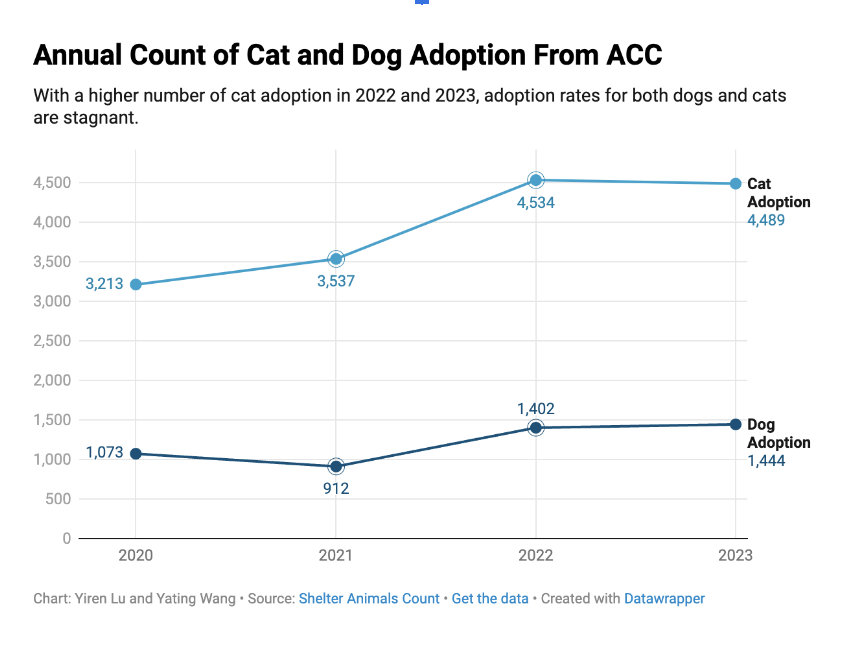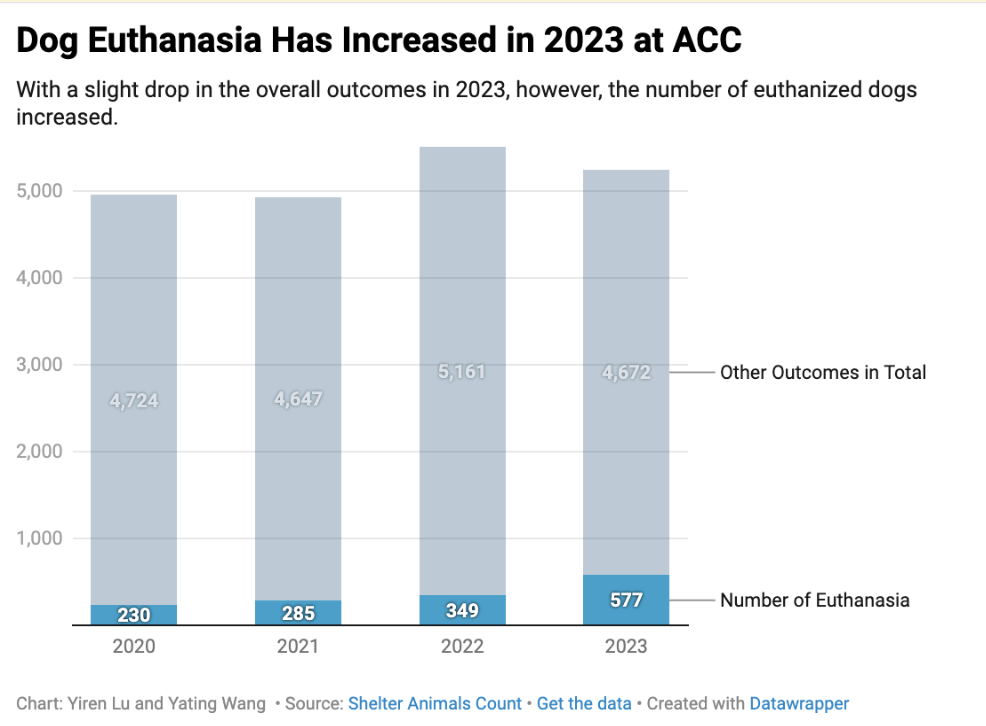
Dozer is 2 years old. Two months after he arrived at Manhattan Animal Care Center, he is still unclear of where his forever home is.
Dozer’s story is not unique at all. In the cramped space of endless barking and almost unbearable hygienic conditions with kennels almost taking up the hallways, many four-legged friends are anxiously waiting for an adopter, a foster parent, a transfer to New Hope, or just a non-kill placement of any kind.
Similar to Manhattan Animal Care Center, the rest Animal Care Centers of New York City (ACC), the biggest city-contracted animal welfare organization providing shelters and a variety of animal care across all five boroughs, are all overpopulated.
As New York City’s only open-admission shelter, Animal Care Centers (ACC) follows a “no animal left behind” policy, taking in every surrendered or rescued creature. This commitment has pushed the shelter to its limits.
Since 2021, ACC has faced a surge in stray animals, worsened in August 2024 around the time when ACC opened their Queens facility. Yet, adoptions haven’t kept pace, leaving the shelter overwhelmed.

Given the huge number of intake, ACC is accommodating more dogs than the space allows. Regardless of full capacity, hallways are crowded with extra kennels at Manhattan ACC, forcing employees and potential adopters to constantly make space for another one to pass.
ACC declined requests for an on-site interview, citing the staff’s “tightly packed schedules with various responsibilities,” according to Kate Hansen, the media spokesperson for Animal Care Centers.
Under pressure for months, the monthly dog intake at ACC has increased from 1331 to 1578 from July to August since the Queens ACC opened, leaving almost 200 dogs in infinite waiting time for an adoption, return to owner or transfer to another rescue or shelter. In other words, a live outcome.
Most kennels are taken up by medium-sized dogs ranging from pit bulls, Labrador retrievers to mix-breeds, urgently demanding a non-kill placement. Qualified adopters, after a short interview with on-site employees, are able to take these dogs back home the same day of the adoption request.
On the other hand, adoption of small-sized dogs requires an online application, followed up with a mandatory appointment for a short interview about one’s ability to take care of the dog.
Barely any dog adoption is taking place on a Sunday afternoon. As ACC reported, only less than fifty dog adoptions are added to the total dog adoption between 2022 and 2023.
In comparison, pet adoption was booming during Covid. “2020 was a true anomaly in animal rescue - we've never seen anything like that,” said Mallory, the marketing representative of Muddy Paws, a dog rescue based in New York City. “These days, we are definitely back to 'normal' pre-2020 levels,” she added.
In 2021, the total dog adoption has dropped more than a hundred compared to 2020.
The average length of stay for an animal, according to ACC’s report, has gone from five to seven days to roughly two weeks and a half. Not only adoption, but animal foster, which allows a short-term commitment to pets, has experienced longer holding of animals. “It has become a bit more challenging to recruit and retain” foster parents post-covid, as the representative from Muddy Paws commented.
For medium-sized dogs who are medically and behaviorally perfect, they may linger around longer due to their looks. “Dogs of all sizes end up in shelters, but larger 'blocky headed' dogs definitely make up the majority of pups that go to ACC,” said Muddy Paws.
Aiming to place dogs in a timely manner, ACC has created a list called Priority Placement Dogs, highlighting dogs that should be prioritized by adopters. Most of the dogs on the list are either exhibiting difficult behavior or have a length of stay of more than 30 days.
Another purpose of the list is to “avoid having to make difficult euthanasia decisions based solely on space constraints,” written by ACC on their web page. Euthanasia is “a last-step, end-of-the-road option to spare animals further hardship and suffering,” according to American Society for the Prevention of Cruelty to Animals, an animal advocacy group.
Already undertaking more pressure to find an animal a long-term placement, ACC inevitably has to carry out more euthanasia. The rate of euthanasia has increased over the years from six percent to 11 percent in 2023.

It is determined by multiple factors, such as the health of the animal, their canine behavior level, or if they are able to be safely placed in a home. Limited shelter space is “the last factor that no shelter ever wants to have to take into account but sadly it does come into play,” said Muddy Paws.
ACC’s statistical reports also indicated that different species faced different challenges.
Compared to larger and more assertive dogs, cats tend to appeal more readily to potential foster caregivers. While Animal Care Centers (ACC) of NYC keeps an emergency list for dogs in immediate danger of euthanasia, cats don’t face the same level of urgency.
Cats in shelters typically find homes more quickly than dogs, and this trend has been steadily growing in recent years, with adoptions becoming increasingly common.
However, this encouraging adoption landscape isn’t solely due to fosters favoring cats. ACC rescues significantly more cats than dogs, reflecting a higher intake of felines from both the streets and owners who can no longer care for them. The number of cats arriving at the shelter continues to grow year after year
Although the overall figures differ, the euthanasia rates for cats and dogs are similar. However, because more cats are brought into shelters, a larger number of them are euthanized compared to dogs. This disparity highlights the challenges faced by shelters in managing the higher feline intake.
Cecile Goyette, co-founder of Bronx Tails Cat Rescue, explained that the euthanasia total is composed of several factors.
“People might, under circumstances where the cat is perhaps irretrievably ill, and they can't afford to get the cat euthanized else,” Goyette said. “They also might do it where the cat is really behaviorally problematic, and they cannot handle—they either don't have the will or the skill to overcome or help the cat get into a better behavior.”
Cats face a unique risk of abandonment compared to dogs, influenced by cultural factors.
“People don't abandon dogs the way they do cats,” Goyette said. “There is this sort of mythology that cats will find a way or some garbage to eat when abandoned.” She also noted that there is “a real stigma” associated with abandoning dogs that doesn’t apply as strongly to cats.
Other reasons like higher reproduction rates also make stray cats more common than dogs.
Outside the Manhattan ACC, a small group stood quietly on an unremarkable Saturday afternoon, buzzing with anticipation. Some parents brought children, who peeked curiously through the shelter’s doors, eager to meet their new furry family members.
A minivan rolled to a stop, and two staff workers emerged, lugging a cage that quivered with movement. Inside, two tiny kittens pressed their pink noses to the wire, wide-eyed and mewing softly. The workers carried the cage inside to a narrow corridor outside the cats’ room.
The corridor felt cramped, the air thick with the mingling scents of animals and disinfectant. Across the room, two pit bulls sat stiffly behind enclosures, their sharp eyes tracking visitors. Their ID cards revealed behavior levels of 2 and 3—a warning of quirks in social interaction. These dogs needed fosters with patience and skill to manage their moods.
Today, pet adoption is not as promising as it was during the pandemic. For thousands of animals waiting for a safe placement or a forever home, each passing day brings pressure on both the creatures and the shelter.